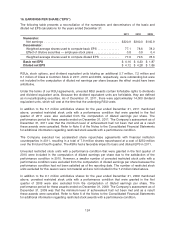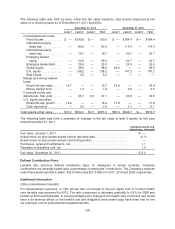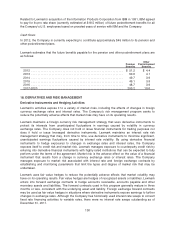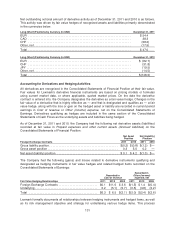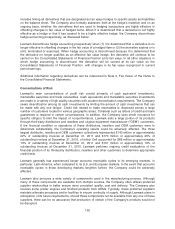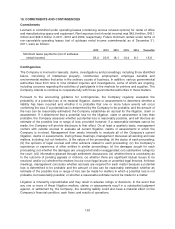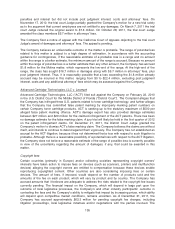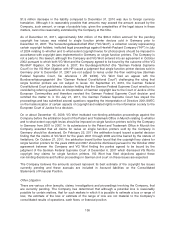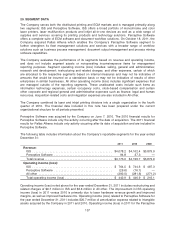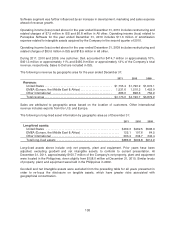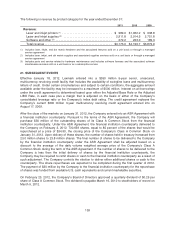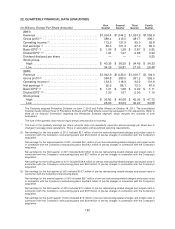Lexmark 2011 Annual Report Download - page 137
Download and view the complete annual report
Please find page 137 of the 2011 Lexmark annual report below. You can navigate through the pages in the report by either clicking on the pages listed below, or by using the keyword search tool below to find specific information within the annual report.
19. COMMITMENTS AND CONTINGENCIES
Commitments
Lexmark is committed under operating leases (containing various renewal options) for rental of office
and manufacturing space and equipment. Rent expense (net of rental income) was $45.9 million, $43.1
million and $48.3 million in 2011, 2010 and 2009, respectively. Future minimum rentals under terms of
non-cancelable operating leases (net of sublease rental income commitments) as of December 31,
2011, were as follows:
2012 2013 2014 2015 2016 Thereafter
Minimum lease payments (net of sublease
rental income) 29.4 22.9 18.1 13.4 8.1 15.6
Contingencies
The Company is involved in lawsuits, claims, investigations and proceedings, including those identified
below, consisting of intellectual property, commercial, employment, employee benefits and
environmental matters that arise in the ordinary course of business. In addition, various governmental
authorities have from time to time initiated inquiries and investigations, some of which are ongoing,
including concerns regarding the activities of participants in the markets for printers and supplies. The
Company intends to continue to cooperate fully with those governmental authorities in these matters.
Pursuant to the accounting guidance for contingencies, the Company regularly evaluates the
probability of a potential loss of its material litigation, claims or assessments to determine whether a
liability has been incurred and whether it is probable that one or more future events will occur
confirming the loss. If a potential loss is determined by the Company to be probable, and the amount of
the loss can be reasonably estimated, the Company establishes an accrual for the litigation, claim or
assessment. If it determined that a potential loss for the litigation, claim or assessment is less than
probable, the Company assesses whether a potential loss is reasonably possible, and will disclose an
estimate of the possible loss or range of loss; provided, however, if a reasonable estimate cannot be
made, the Company will provide disclosure to that effect. On at least a quarterly basis, management
confers with outside counsel to evaluate all current litigation, claims or assessments in which the
Company is involved. Management then meets internally to evaluate all of the Company’s current
litigation, claims or assessments. During these meetings, management discusses all existing and new
matters, including, but not limited to, (i) the nature of the proceeding; (ii) the status of each proceeding;
(iii) the opinions of legal counsel and other advisors related to each proceeding; (iv) the Company’s
experience or experience of other entities in similar proceedings; (v) the damages sought for each
proceeding; (vi) whether the damages are unsupported and/or exaggerated; (vii) substantive rulings by
the court; (viii) information gleaned through settlement discussions; (ix) whether there is uncertainty as
to the outcome of pending appeals or motions; (x) whether there are significant factual issues to be
resolved; and/or (xi) whether the matters involve novel legal issues or unsettled legal theories. At these
meetings, management concludes whether accruals are required for each matter because a potential
loss is determined to be probable and the amount of loss can be reasonably estimated; whether an
estimate of the possible loss or range of loss can be made for matters in which a potential loss is not
probable, but reasonably possible; or whether a reasonable estimate cannot be made for a matter.
Litigation is inherently unpredictable and may result in adverse rulings or decisions. In the event that
any one or more of these litigation matters, claims or assessments result in a substantial judgment
against, or settlement by, the Company, the resulting liability could also have a material effect on the
Company’s financial condition, cash flows, and results of operations.
133



